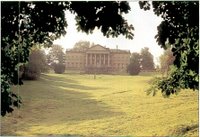
Welcome to the last day to enter your name for a chance at one of TWO 10th Anniversary Collector’s Editions of A&E’s Pride and Prejudice. If you haven’t already, check out the contest rules and learn more about the prizes at the A&E store.


In Pride and Prejudice, even more than in in other Austen stories (except maybe for Mansfield Park, of course, where the house is the title!) locations seem to become like characters in the tale. Darcy’s Pemberley=grand, glorious, beautiful, elegant, aristocratic in the best sense of the word, able to add to Darcy’s already great attractions. Lizzy, after all, tells Jane she first started to love him when she saw his “beautiful grounds at Pemberley!” 🙂 Longbourne=comfortable, prosperous enough, maybe a bit shabby in a cozy way. Rosings=huge, imposing, overwhelming, gaudy (though of course Lady Catherine DeB. doesn’t think so! She paid 800 pounds for the window glazing alone!). These houses are representative of the characters who live in them, an extension of their personality, symbols of their place in the world. With such heavy expectations placed on the poor houses, I don’t envy any location scout sent out to find them!
In the book The Making of Pride and Prejudice (chock full of great pics and behind the scenes info) there’s a whole chapter on “Location Hunting,” detailing the searches far and wide for the perfect Pemberleys and Longbournes. It’s all a bit like the hunt for Scarlett O’Hara in 1939!
In the end, Luckington Court stood in for Longbourne, which was the most complicated to find since it required “a drawing room, dining room, library, large hall, staircase, landings, and three bedrooms, as well as extensive gardens” (a prettyish wilderness?).
Pembroke, the grandest house in the story, was actually two places–the exteriors at Lyme Park on the Cheshire/Derbyshire border, the interiors at Sudbury Hall in Derbyshire. The Making of Pride and Prejudice states “Some people think Jane Austen was thinking of Chatsworth House as Pemberley, but in fact Chatsworth is referred to in its own right in Pride and Prejudice. (though Chatsworth was used in the 2005 movie)
Rosings was Belton House in Lincolnshire, “a splendid Restoration country house with wonderfully formal gardens to the front.” Mr. Collins’ rectory was found nearby (of course!) at The Old Rectory at Teigh.
Meryton was actually a beautiful village, Lacock, in Wiltshire, which I was lucky enough to visit a couple of years ago (and Diane, too!). It was so much fun to get to wander around finding all the locations from the series–“Oh, look, the assembly rooms! Hey, there’s where they saw Darcy and Bingley riding past when they met Wickham!” Yes, I am a P&P geek and I don’t care who knows it!!!
What would your ideal Regency abode be like? The perfect place to live with your Number One Austen Hottie from Cara’s post, to store your fab Regency wardrobe and all your Austen–and Risky Regency–volumes? (Personally, I’ve always been a sucker for a cozy cottage, with climbing roses over the door and a large fireplace where Matthew and I could curl up together in the evenings…)
Plus a few links (in case you want to plan your own P&P tour!):
Lyme Park
Sudbury Hall
Chatsworth
Belton House
Lacock




